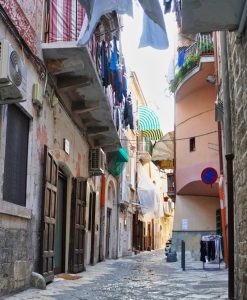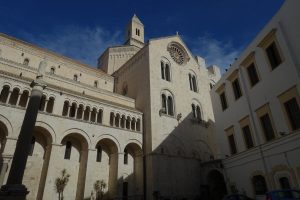Large and massive, the landmark of the city of Bari, the Castello Normanno-Svevo di Bari, stands on the edge of the old town. You should definitely plan a visit to the Bari fortress during your visit to the city.

History of the fortress
The fortress of Bari dates back to the Middle Ages and was probably built from 1132 onwards by the Norman King Roger II of Sicily. Originally, there were residential buildings from the Byzantine period, which were built over by the fortress.
Only a few years later, the Baresians with William the Wicked destroyed the fortress complex and almost the entire city.
Emperor Frederick II of Swabia had the castello rebuilt and fortified in 1233. In the following years, the various owners rebuilt the complex several times. Thus, massive ring walls were built around the Norman-Swabian core building at this time.

After the Kingdom of Naples took over the complex, it was converted into barracks and a prison. At that time, the northern side of the fortress was surrounded by the sea and the other three sides were protected by ditches.

Visit to the fortress of Bari
Today, the fortress no longer stands directly on the sea, so you can walk completely around it. The former moat is green and a few palm trees grow along the edge. Behind it rise thick, high and unadorned walls with large pointed corner bastions. Everything is designed for good defence and only a few openings face outwards.

The entrance is on the south side of the Bari Fortress. A stone bridge leads to an entrance door that leads to a small anteroom, where the ticket office is located.

Between the high outer and inner walls, which were built in the 16th century, the path leads to the Suevic keep in the inner courtyard. The inner courtyard is completely paved with stones. A small fountain stands at the edge and a generous flight of steps leads to the upper floor of the building.
Exhibitions in the Fortress of Bari
From the courtyard, you can access the exhibition rooms of the fortress complex, which are located on the ground floor and upper floor.

First we were drawn to the ground floor of the fortress complex. Here, the remains of the original Byzantine buildings are shown in one area. These were discovered during restoration work and the area was built over in such a way that you can look down on it from above. The area is well lit, but there is not much more to discover than the remains of the walls. Unfortunately, there are only a few information boards (in Italian and English) that provide more detailed information about the archaeological finds.

On the ground floor there is also the Gipsoteca. A collection of plaster copies is exhibited here. Sculptures and carvings from the most important monuments and cathedrals in Puglia are on display. The plaster models were created around 1911 by the sculptors Pasquale Duretti and Mario Sabatelli for an exhibition.
Since 2017, after extensive restoration work, some rooms on the first floor have also been opened. These rooms were once used by the noble owners of the complex. Just to take a tour of these rooms without looking at the exhibitions there is beautiful. The vaulted ceilings stretch high above the room, windows let in light and only the thick walls remind you that you are in a fortress.

Today, you walk from room to room and can discover the most diverse exhibition areas. In the Angoina Hall, for example, there is a beautiful collection of ceramics. The exhibits date from the 15th-18th centuries and were largely discovered during excavations on site.
In the Aragonese Hall you can see a great photo exhibition on the subject of the Fortress of Bari. Here you can read about the restoration work and the use of the fortress.

The Norman Hall shows exhibits that are directly related to the fortification. For example, there are stone figures, column endings and frieze pieces to see. Many of the objects are excellently illuminated, which makes them look even more beautiful.
Two further exhibition areas are used for temporary exhibitions and events.

The exhibition areas are interesting and well suited for a short visit. We were there for about 1.5 hours and were able to look at everything at our leisure.
Address:
Piazza Federico II di Svevia, 4
70122 Bari
Admission fees:
Adults: 6,-€
Opening hours:
Wednesday – Monday: 9-19 h
Tuesday: closed








Leave a Reply